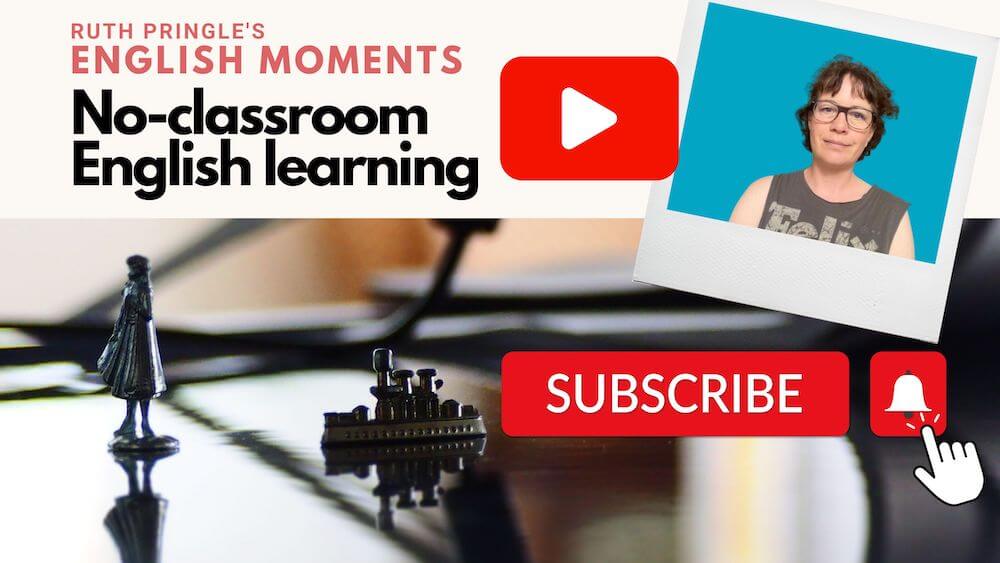Our Best Tips for Using Films/TV to Learn English
Watching films and TV in English is a good language boost, and relatively simple to implement as they are so accessible.
However, before you settle down on the sofa with the subtitles on, you need to know there is a scale of usefulness.
This means that some formats and methods will be better for you than others.
This partly depends on YOUR personality, interests and language learning style. It is also about differentiating active learning from passive learning.
Are you just letting words wash over you? Or are you making notes? Rewinding parts you don’t understand?
Both active and passive watching are better than nothing, and both have their place.
However, if you are only learning passively, ask yourself how you can push a passive activity into an active one. You will learn more and faster.
This blog is full of tips for using TV, Youtube and films to learn English, both actively and passively.

It has Got to Be Right for You
Don’t get the balance between active and passive wrong for your energy. If you strip all the pleasure from the activity, it is likely that you will stop doing it at all.
One solution may be to follow an English coach on YouTube, and do 20 minutes of active learning every Monday, fitting in a further 30 minutes of daily passive learning, even with subtitles on, while commuting.
Above all, pay attention to what works for you and the different environments you are in.
Start a quest to discover what methods works best for your learning style, can fit around your lifestyle – and which you actually enjoy!

TV Works for Many
In this TED talk, polyglot Lýdia Machová describes watching and rewatching Friends to absorb her new target language.
However, she quickly describes the different methods fellow polyglots use – and they are hugely different.
The only similarity is that the methods are matched to the learner’s personal interests.
I love this video because it gives us all permission to find our thing. If you hate Friends, don’t start watching it in English because it worked for a polyglot.
Above all, you need to be looking for a format or formats that you are excited to show up for.
“So if you’ve also tried to learn a language and you gave up, thinking it’s too difficult or you don’t have the language talent, give it another try.
Maybe you’re also just one enjoyable method away from learning that language fluently.”
Lýdia Machová, 2018

Why TV & Film Might Not Work for You
If you pick a show in which understanding the dialogue is necessary to the plot, it’s easy to get lost.
One tip is to find a source in which you understand at least 60%.
Or a film or TV show you have seen a few times before.
Finding film resources to practice English as a second language is harder than it sounds.
If you like rewatching old shows – no problem, but many of us don’t.
Don’t make the mistake of thinking watching kids’ TV/cartoons will be easier. Cartoon voices are fast, and you can’t see their lips moving accurately, which is key to understanding speech.
Plus, unless you already love cartoons, dumbing down your TV watching will quickly put you off.

Tips for Using TV to Learn English | Desperate Housewives
If you like American TV, this series is a little easier to follow because in every episode a narrator sets the scene.
The story is entertainingly and visually acted out (almost theatrically).
A lot of vocabulary is repeated. Every episode ends on a ‘cliffhanger’ which makes you want to show up and find out what happens next.
If you hate this style of American TV show, good. A clue! What do you like instead?
Cooking? Gardening? Travel? Sport?
It’s ok to watch ‘dumb stuff’ for language learning.
I’d love to be the kind of French learner that reads Zola. I’m not. I’m the kind that reads Sophie Kinsella. The point is I haven’t given up with the romantic novels, and I keep picking them up. Zola is still gathering dust on my bookshelf.

Group Watching Films to Learn English
If you have peers on the same English quest, you can group watch – or at least choose the show and set yourself the challenge of watching it weekly.
As well as offering accountability benefits, coming together to discuss what you saw rehearses the vocabulary you have just been introduced to.
If you don’t have a community, some shows have X (Twitter) feeds that inspire a lot of debate (MAFs Australia is just one example).
For free English practice, the social media platform Clubhouse has film and TV-themed rooms where you can just listen, or listen and chat.
Alternatively, you can find online English teachers offering Learn English With Films as a course. This brings people around the world together in a curated, and language-supported watch party, which is supplemented by a conversation practice English class on Zoom.
Great for film fans!

Have You Found Youglish Yet?
Youglish is a website which uses YouTube’s search box as a way to learn English. Working on pronunciation? Type a certain word into the search box, and YouGlish gives you clips where the word is spoken.
It’s a great tool if you are learning English for a Specific Purpose – like certain workplace vocabulary.
It’s a fun ‘rabbit hole to fall down‘ if you don’t use it with clear learning objectives.
For example, general English learners could watch a TV show, make notes of the words they didn’t know (switch the subtitles on to get the correct spelling) then drop those words into Youglish sometime after the show).
Don’t make it too hard. Aim for 7 new words per 30/40 minute episode.
Help yourself to make it easy. Keep your notebook and pen near your TV remote*.
*This is the kind of obvious advice that is so simple it gets missed – or risks sounding patronising. James Clearly‘s book Atomic Habits is a must-read introduction to habit stacking – essentially making it as easy as possible to do your new habit. Consider the inverse, spend 10 minutes trying to find a pen = not doing it at all next time).

Videos for English Learners
Of course, there is a wealth of YouTube videos, Instagram Reels & TicToks made by English teachers to attract an English learner audience.
The good examples keep you entertained or informed, and coming back for more.
Avoid any that tell you what mistakes you are making or what not to say.
Firstly, it’s really bad practice for a teacher to speak mistakes out loud. Your brain hears and remembers the voiced mistakes just as well as the correction, which will confuse you in the future when you have to recall it.
Secondly, any content that is all about mistakes is intended to generate fear and anxiety in learners to sell products. Avoid this stress and toxicity by unfollowing any accounts.
From now on, only follow people who make you feel good about your English.
There’s still plenty to help you!

How to Use Free Content
Be aware that consuming free content is a scattergun approach to language learning.
By all means, find a few whose style you enjoy and follow them, but know that this is only one part of an English learning strategy, not the whole.
Following 10 different English teachers will not give you anything like the structured learning of one paid course, even an online group course (often the cheapest option).
The scattergun approach can overwhelm and ultimately put you off if it is the only method you use.
Put structure across your English learning – by all means, add 30 minutes of English lessons on Instagram into your schedule.
But stop scrolling and nodding and getting distracted by piano-playing cats.
Follow certain accounts, and visit only them during English time. Make notes. Practice out loud after every video.
‘Follow’ me on YouTube – and never miss a chance to learn English.
An Immersion English Experience on YouTube
My own YouTube Channel is a little different.
I make immersion English videos that give you comprehensible English which narrates what you see on screen. (It’s really not a Scottish version of Desperate Housewives!)
Unlike most English teacher content, I don’t tell you how to speak English. Instead, I give you a way of helping yourself to English.
It’s active learning.
With my YouTube channel, you have a visual listening source that you can more easily understand than native TV or film.
The content is for adults (and not dumbed down like many ELT sources).
I love exploring and sharing parts of Scotland with you. It’s what I do on my English immersion holidays, and I try to recreate this with film.
My YouTube channel is for anyone with an interest in culture, seeking weekly active listening comprehension practice.
For example, in A Visit to Tibbermore Church, I explore a gem of a Perthshire building.
In the episode notes (below the video on YouTube) I give you 3 questions to listen out for.
Try it and see!
Give Your Brain a Confidence Boost
With my visual listening video method, a learner understands more than they would in a conversation without visuals.
This is a deliberate confidence boost. Giving yourself the opportunity to feel that you understand spoken English isn’t cheating. It is relaxing into English learning, taking the fear and anxiety out – and showing you that you can have faith in your English learning future.
If you always pick language learning sources that are too difficult for you, you will convince your inner voice that you ‘can’t do it’.
Trust me, my English is all about ‘can do it’!
Because you can. You just need to find the right path.

Using YouTube, TV and Films to Learn English
Like much in English learning, you need to determine your own path through the huge range of possibilities.
Don’t be too overwhelmed by choice to even begin.
Pick a format. If you don’t enjoy it, change something about the way you are watching – or move on to something else.
Make it consistent. Whether you can do an hour a day or an hour a week, make sure it is scheduled and you stick to it.
Further Information
Blue Noun Language Hub
We have a system to help you find the online English teacher who can help you best.


